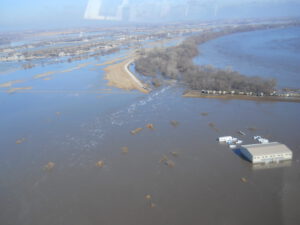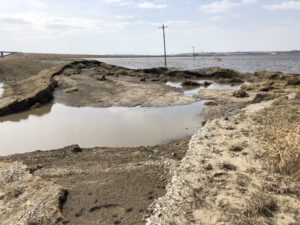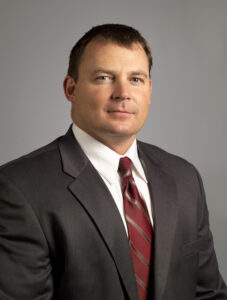T
he Papio-Missouri River Natural Resources District (NRD) is located on the Missouri River near the city of Omaha, Nebraska. The district is also bordered by the state’s other two major rivers, the Elkhorn and the Platte. The district has broad responsibilities managing the area’s natural resources, including flood planning and control.
In this interview, John Winkler, general manager of the Papio-Missouri River NRD, speaks with Municipal Water Leader Editor-in-Chief Kris Polly about the record-breaking flooding his district suffered earlier this year and how he and his staff responded to the event.

Kris Polly: Please tell us about your background and how you came to be in your current position.
John Winkler: I will have been with the district for 13 years in December 2019. I have a bachelor’s degree in political science and a master’s in public administration, as well as a certification in mediation and negotiation, which comes in handy when dealing with the legislature and boards. Before I came to the NRD, I was the city administrator of Plattsmouth, Nebraska, which also experienced some significant flooding during this event. I was born and raised in Omaha, Nebraska, and I live along the Platte River, so I’ve experienced it at its best and worst.
Kris Polly: How much riverfront does your NRD have?
John Winkler: Our NRD encompasses about a third of the Missouri River in Nebraska, and our southern and western borders are the Platte River and the Elkhorn River, so the three major rivers of the state flow through and around our district.
Kris Polly: What kind of damage did the NRD experience?
John Winkler: Several of our levee systems overtopped, and we had at least two breaches, one along the Missouri River and one along the Platte River. The latter flooded Valley, Nebraska. There are numerous scour holes and washouts along the levees, and there are significant amounts of debris and silt, which is a big problem. Inside the Omaha metro area and the Papillion Creek basin, where we have a number of dams and levees, the system performed impeccably. There was little damage in the greater Omaha metro area. It was along the three major river corridors that the systems were overtopped or failed. The reason for that is that besides a few levees, there’s not a whole lot of control on the Platte and the Elkhorn. There are no dams to speak of, and there is no robust levee system along those. Of course, the Missouri is different. There is the U.S. Army Corps of Engineers mainstem dam and levee systems around Omaha. We’re still assessing the damage, because the floodwaters took a while to reach some locations. Right now, we’re focusing on getting the breaches repaired and armoring some of the weaker spots in preparation for the next high-water event.

Kris Polly: What are the NRDs’ responsibilities with regard to flooding and flood control?
John Winkler: That is the main mission of NRDs. We are involved in constructing and maintaining levees, working with our communities and the state, and constructing all the reservoirs in our district. NRDs construct flood control reservoirs across the state. This is the wetter part of the state, so we have to worry about flash flooding.
Kris Polly: What was your experience with the flood?
John Winkler: This was such an overwhelming, fast event that there was little time to prepare. In 2011, we had a month or even longer. The Army Corps informed us about its planned releases and the expected level of the water. This time, the river was literally rising 1–2 feet an hour. We were trying to reinforce low spots on the levees where possible and making sure that people were safe and taken out of harm’s way. Trying to keep Offutt Air Force Base and the Omaha treatment plant dry was a huge issue for us, but we just got overwhelmed. There was nothing we could possibly have done to stop it. We tried to save all the material and infrastructure we could and keep everybody as safe as possible. We didn’t assist with evacuation, but we consulted with the weather service and the emergency management folks. We kept contact with the lake communities along the river, asking about the situation on the ground in real time.
Kris Polly: Did all three of those rivers flood?

John Winkler: All three were at record highs in many of the locations throughout our district. The Platte River exceeded the previous record by about 2 feet. The Elkhorn was about 3 feet above its record height. The Missouri River, right at its confluence with the Platte, was 4–6 feet above any previously recorded height. Flood stage on the Elkhorn River is 14 feet and it peaked at 22 feet, flood stage on the Platte River is 9 feet and it peaked at 13.7 feet, and flood stage on the Missouri is 26 feet and it peaked at 40 feet during the recent event.
Kris Polly: Do you have any preliminary figures totaling up the damage caused by the flooding?
John Winkler: We have recreational areas along the Platte and the Elkhorn that are completely decimated. Levee repairs will cost tens of millions of dollars. I would also expect an additional $5 million to be added to our $22.7 million construction contract for the Missouri River levees that protect Offutt Air Force Base because of the damage some of those levees suffered. We hadn’t started that project, which was fortunate, because whatever had been built would have been compromised and damaged.
Kris Polly: Have you started to do repair work?
John Winkler: A lot of our levee systems are in the Public Law 8499 program, so we’ve been working with the Army Corps to quickly take action in the areas where the levees were breached. We’re doing what we can to protect our assets and investments. We went in and fixed one of them by ourselves because the Army Corps could not get to it fast enough. The Army Corps has been responsive, but its whole system from Omaha to Missouri was completely destroyed—a lot of the levees aren’t even there anymore— so its plate is full.
Kris Polly: Do you do construction work yourselves, or do you contract for it?
John Winkler: We do a lot of the construction ourselves. However, we do contract the work on big levee breaches out to other firms and general contractors. We have quite a bit of equipment, but our resources are spread thin right now, so we’re contracting with bigger construction companies to take lead on those priority areas.
Kris Polly: How many employees you have?
John Winkler: We have 50 for a six-county area, including engineers and accountants and equipment operators. There are 10–15 maintenance folks who are out in the field doing repairs and cleanup. A lot of people have worn a lot of different hats during this event and done jobs they don’t usually do. Everybody has stepped up. We had a number of people during the flood, myself included, who had homes and families in harm’s way. No one even spoke a word about abandoning their posts. We had work to do, and they didn’t waver. They stayed at it 24/7 for quite a while during that whole event. They took their jobs extremely seriously.
Kris Polly: What has been the public reaction to the flood and to your work fighting it?
John Winkler: We’ve been to a lot of community meetings. People have lost their homes and possessions, and their lives have been turned upside down, but few, if any, did any finger pointing. I don’t know if it’s just the midwestern mentality, but people came up to me to shake my hand, and I would look them in the eye, and they would say, “You know, we really appreciate what you did during the flood.” A lot of our infrastructure performed impeccably, especially in the greater Omaha area. People there didn’t even realize they were in any danger. I take that to heart. It’s my job to do everything I can to make sure that people are safe. We are working to mitigate as much risk as possible. No matter what we build, there’s always the potential that an event can overwhelm it, but I take some comfort in knowing that we have done everything that we could up to this point and that we’re going to do more.
Kris Polly: What is your message to Congress?
John Winkler: Both Congress and the state legislature need to put resources into infrastructure. You cannot complain that we need better infrastructure and hope that it appears by itself. There are no levee fairies or dam fairies to build these things. It takes money, it takes investment, and it takes time. The regulatory environment needs to be improved. Permits need to be given faster. We waited 6 years for a permit to rehab the Missouri River levee. Arguably, if that levee system had been done, the Air Force wouldn’t be spending a half a billion dollars on repairs on its base. This event is a wake-up call, but how many wake- up calls have we had? The flood in Nebraska in 2011 should have been one. Everyone rushes to talk about what they are going to do in response, but 1 or 2 years later, they decide the solutions are too expensive. People have short memories. I don’t want to wait around for another 5–10 years and then have people act surprised when another flood happens. It’s really frustrating.
Kris Polly: It’s a safe prediction that the Missouri will flood again.
John Winkler: It will. The Platte will flood again, and the Elkhorn will flood again. Just in my lifetime, I’ve seen high-intensity rain events become more frequent. I am not a climate scientist or a meteorologist, but I can surely tell you that in this area, we are seeing higher-intensity storm events that dump a ton of rain in a short period of time. That’s what we’re building for. Funding and permitting mean that it takes us 10 years to build a reservoir, but it only takes developers 2 years to fill a 300-home subdivision. They’re building things faster than we can keep up. That can’t continue. It just does not work.
John Winkler is general manager of the Papio-Missouri NRD. He can be contacted at jwinkler@papionrd.org or at (402) 616-2457. For more about the Papio-Missouri NRD, visit www.papionrd.org/.
